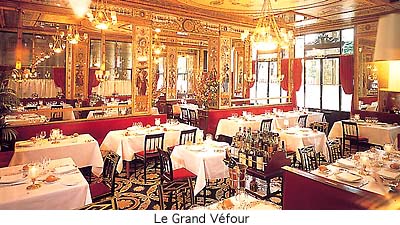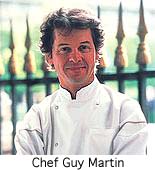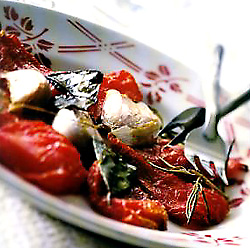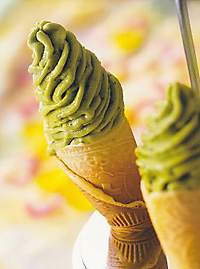Lunch at Le Grand Véfour
Husband and wife food writers experience an historic 3-star Parisian restaurant
by Fred Ferretti Before us, arranged upon a plate of glistening white, discretely bordered Limoges, lay ravioles de foie gras à l'émulsion de crème truffée, beautifully fashioned pockets of thin pasta filled with fresh goose liver and minced green cabbage held together with truffle oil and dressed with a creamed mousse of black truffles. Next to these were moist slices of a terrine of foie gras, accompanied by toasted brioches and small mache salads speckled with chopped black olives.
Before us, arranged upon a plate of glistening white, discretely bordered Limoges, lay ravioles de foie gras à l'émulsion de crème truffée, beautifully fashioned pockets of thin pasta filled with fresh goose liver and minced green cabbage held together with truffle oil and dressed with a creamed mousse of black truffles. Next to these were moist slices of a terrine of foie gras, accompanied by toasted brioches and small mache salads speckled with chopped black olives.
"Oh, my goodness," said my wife. "Do you think Colette ate like this every day?"
"Absolutely," I replied. "Why not? Quickly, finish your champagne while the bubbles still bite, our Meursault is coming."
Lunch at Le Grand Véfour was proceeding.
Few restaurants in Paris, or for that matter anywhere, are the equal of Le Grand Véfour for innate grandeur, for historic context, for graciousness of service and, to be sure, for the brilliance and taste of its cooking. No wonder that decades ago an ailing and aging Colette insisted upon being carried down from her apartment upstairs to the lovely refuge under the arcade of Palais Royal and deposited into her favored burgundy velvet banquette, there to eat, drink, snipe at the haute monde, reign.
I have eaten at Le Grand Véfour on and off for twenty years, initially attracted by its history as well as its classic French table, the heritage of its once and storied cook Raymond Oliver, later for the mastery of Guy Martin, its chef now, a self-styled outsider who came down from the Savoy in the French Alps twelve years ago to set Paris on its gastronomic ear with daring, often unusual, yet classic cooking.
 Martin, at 43, a great cook, confident in his humility, had sent me a copy of his book, "Vegetables," without question the finest and most original meatless, fishless cookbook extant. My wife, Eileen Yin-Fei Lo, the ultimate source for all Chinese cooking, had composed a similar book, "From the Earth: Chinese Vegetarian Cooking," and I had written to Martin suggesting to him that on our next visit to Paris he and she must meet.
Martin, at 43, a great cook, confident in his humility, had sent me a copy of his book, "Vegetables," without question the finest and most original meatless, fishless cookbook extant. My wife, Eileen Yin-Fei Lo, the ultimate source for all Chinese cooking, had composed a similar book, "From the Earth: Chinese Vegetarian Cooking," and I had written to Martin suggesting to him that on our next visit to Paris he and she must meet.
His response was immediate and enthusiastic. Please come, he wrote to me, we will drink champagne and talk about vegetables. So that morning in June, well before lunchtime we walked the short distance from our hotel, the Meurice, on the Rue de Rivoli to the Place du Palais Royal, then into the long arcade to Le Grand Véfour to meet with Guy.
And a lovely visit it was, up in a tiny balcony loft over the restaurant. He and Eileen spent a good deal of time discussing the properties and merits of garlic, fennel and chives, of celery stalk tartes and spring onion pancakes, of vegetarian oysters created form eggplant, ginger and onions and of white mushroon canneloni, while I drank champagne, Taittinger to be sure, since one must, out of politeness, drink house wines, and the House of Taittinger has owned Le Grand Véfour for twenty years.
The contents of the bottle were quite low when Guy interrupted a dissertation on the wonders of the baby vegetables sent daily to him from the Loire to say that he would be pleased if we were to stay for lunch. My wife hesitated, pointing out that she was wearing neither her best trousers nor her best blouse. And I had on an open-neck sportshirt and sneakers. No matter, said Guy, and soon I had on a jacket fashioned for someone who had abnormally long arms, with its cuffs folded back; Eileen a borrowed silk scarf, thrown casually over her left shoulder, and we were shown to Colette's corner banquette, so marked with a tiny brass plaque.
The sun slanted downward in through the velvet-draped rear window of the restaurant and outside bounced bits of light off the parade of trees in Louis XIV's Jardin du Palais Royal. From our seats I pointed out another plaque a few seats away. "Emile Zola," it read. Over its 220-year history Jean Anthelme Brillat-Savarin had eaten regularly at Le Grand Véfour, no doubt making notations as to the physiology of taste, and so had Grimaud de la Reynière, another of France's great eaters. Emperor Napoleon Bonaparte, and Josephine, had been customers as had been Victor Hugo, Georges Sand, later Jean Cocteau, Jean Giraudoux, Jean-Paul Sartre, Simone de Beauvoir and André Malreaux. In fact, models of Georges Sand's hands are Le Grand Véfour's ashtrays and Jean Cocteau's drawings adorn its menus.
 A good deal of history, but it sat lightly when, before our foie gras service, we had our mouths amused with tissue-thin slices of artichoke heart dressed with olive oil and lemon juice, tiny roasted wings of petit poussin, a deep-fried basil leaf and a curl of candied orange peel.
A good deal of history, but it sat lightly when, before our foie gras service, we had our mouths amused with tissue-thin slices of artichoke heart dressed with olive oil and lemon juice, tiny roasted wings of petit poussin, a deep-fried basil leaf and a curl of candied orange peel.
"I think Josephine would have liked this," my wife suggested.
"Of course. Why would she not?"
Our foie gras consumed, our plates well cleaned with pieces of baguette, we sipped our Meursault, a Narvaux-Michelot, picked for us by head waiter Christian David, and awaited our next course.
Do you like fish, Guy asked. Oh yes. A different selection for each of us. My sole, "only from Brittany the day before," noted Guy, had been steamed with stalks of both green and white asparagus and dotted with a green asparagus coulis. Red mullet lends itself well to the sautée pan, and Eileen's rouget was sautéed in a bisque-like sauce and served with a sweet and sour salad of fresh chanterelles and a bundle of baby green asparagus. We ate, shared, passed plates to each other and asked for another baguette or two.
"I know Josephine would have liked those," said Eileen. No quarrel. I nodded, chewing.
The remaining drops of white wine were removed, and as glasses were changed, silverware added, we awaited our next course, looking at Georges Sand's hands a couple of tables away and drinking, slowly, a Chateau Beaubois Costières de Nîmes, a wine from southern France generally regarded as a mere vin ordinaire, but not this 2000, a gentle, but full red poured by Christian as he gave my wife a bit more of Véfour's history.
When the gardens of Palais Royal were completed, and opened in 1784, one Antoine Aubertot opened his Café de Chartres, which quickly became fashionable, an important hub of society. Four years later it was bought by Jean Véfour, who decorated it into a grand restaurant, named for himself, that became beloved by such customers as Napoleon, who once described a visit there as a "philosophic experience."
"Like our truffle ravioli?" my wife suggested. "Just so," said Christian.
 Well into the middle of the Nineteenth Century and later, into its passage into the Belle Époque, Le Grand Véfour remained the cultural and dining center of the fashionable Palais Royal neighborhood, along with its neighbors, the Thâatre du Palais Royal and the Comédie Française. Subsequently however, as do most soaring comets, the restaurant tailed downward and during the early part of the 20th Century it became virtually unnoticed until 1948 when, after World War II, Louis Vaudable, the owner of Maxim's, bought it and installed the great Raymond Oliver as its chef. Le Grand Véfour soared once again. Within five years Oliver had brought it three Michelin stars. For 40 years he, and it, were supreme, until 1983 when Oliver retired, the restaurant was damaged by a demonstrator's bomb, and a Michelin star was lost. Désolation.
Well into the middle of the Nineteenth Century and later, into its passage into the Belle Époque, Le Grand Véfour remained the cultural and dining center of the fashionable Palais Royal neighborhood, along with its neighbors, the Thâatre du Palais Royal and the Comédie Française. Subsequently however, as do most soaring comets, the restaurant tailed downward and during the early part of the 20th Century it became virtually unnoticed until 1948 when, after World War II, Louis Vaudable, the owner of Maxim's, bought it and installed the great Raymond Oliver as its chef. Le Grand Véfour soared once again. Within five years Oliver had brought it three Michelin stars. For 40 years he, and it, were supreme, until 1983 when Oliver retired, the restaurant was damaged by a demonstrator's bomb, and a Michelin star was lost. Désolation.
Enter the Taittinger family. Jean Taittinger bought Le Grand Véfour and under the guidance of the government's Monuments Historiques, restored it. The Second Empire paintings on silk, fanciful neo-class scenes from Pompei, now glow under their protective glass. The gilded plaster ceiling was made anew and the gold-leafed carved woodwork glistens. The rugs, à la Aubusson, were recreated and the restaurant was officially classified a "monument historique."
A parade of chefs ensued, but it was not until Guy Martin arrived twelve years ago that the cooking of Le Grand Véfour came to not only match its decor, but to outshine it.
"I cook," he told me once, "like a mother cooks for her children. I cook because I love to cook. I wish to please and to be close to my clients. If one day I find that I cook because I have to, I will stop."
Guy never stopped. His cooking is classically inspired, his obeisance to classic technique complete. But his food digresses, changes, leaps forward, becomes, as Guide Michelin noted when it awarded him three stars, cuisine inspirée.
At which point our next course was set on our table. For Eileen, l'agneau pascal, baby spring lamb, en croûte, encased in pastry, accompanied by a pair of small lamb ribs, a tiny mound of lima beans, small chips of potatoes and a purée of eggplant.
For me a parmentier, that classic of France, simply meat and potatoes, that Martin evolves into a thick round of shredded stewed oxtail, topped with truffled mashed potatoes, these topped in turn by thin slices of black truffle, the whole set off with an intense oxtail reduction. Guy came to our table. "Traditional but exceptional," he said with a smile, and so it was. And did not both meat preparations wed well with our Costières.
"Oh my, yes," said Eileen.
"Um," I agreed.
We drank our Badoit, that marvelous bubbled water found so seldom outside France, while the sorbets of banana and melisse, lemon balm, were brought to cleanse our palates. Then Christian brought us each one of Guy's artichoke tartes, a wonder of a sweet, with artichoke vanilla ice cream, dressed with chopped candied celery and candied carrots. Unusual? Yes. Exquisite? "Oh yes," said Eileen. These, along with the obligatory slices of sponge cake that every customer at Le Grand Véfour must try we ate with glasses of Pineau des Charentes. This combination, from Charentes, usually of cognac and fresh grape juice is, in Guy Martin's restaurant cognac mixed with the pressing of dried raisins, which gives it a direct, deep sweetness.
"Some cheese?" Christian asked.
"Impossible," I replied.
He pointed out however that Chef Martin brings in Bleu de Termignon, a cow's milk cheese from the Savoy that is "rare, very rare," for it's come from "one woman with ten cows."
I patted my stomach apologetically.
Christian was not to be deterred. He wheeled away the cheese trolley, but returned with a tiny package, neatly tied, of Bleu de Termignon for "later on". He was correct. The cheese, together with a long thin baguette from a kiosk in the Place du Palais Royal on the way back to our hotel, was our evening meal. Later.
Before we left Le Grand Véfour Guy kissed Eileen's cheeks three times and hugged me, once, after I had returned his spare jacket, Eileen her borrowed scarf. Off we went. Thoughts of our grand interlude stayed with us, and memories of singing tastes were made the better upon our return from France. Eileen found a letter waiting from Guy Martin thanking her for her vegetable book, adding, "It is beautiful and makes me feel like eating more."
"What a thoughtful thing to do," my wife said. "What a wonderful man."
Indeed he is.
photographs ©Relais & Chateaux

